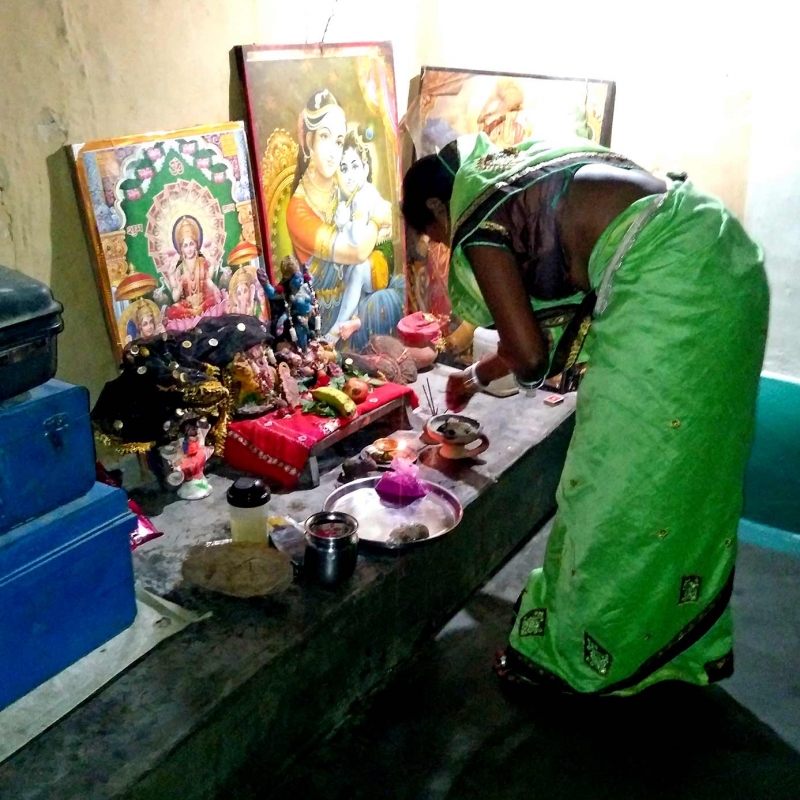Teeja and Ganesh Chaturthi are among the most popular festivals celebrated during monsoon across Chhattisgarh. Despite the distinct regional associations of Teeja and Ganesh Chaturthi, both the festivals have become an integral part of the festive calendar of the state. Teeja is widely celebrated in North India and the eastern states of Bihar, Jharkhand and Chhattisgarh. It is known to be observed by women for the long life and prosperity of their spouses. There are three kinds of Teeja- Hariyali Teej, Kajari Teej and Hartalika Teej. While, Hariyali Teej and Kajari Teej are more popular in the northern and north western states of Haryana, Punjab and Rajasthan, the Hartalika Teej is widely celebrated in Chhattisgarh, Jharkhand and Bihar. Similarly, Ganesh Chaturthi, a festival distinctly associated with the Maratha culture is celebrated with all the rigour and enthusiasm in various parts of Chhattisgarh. The festivals of Teeja and Ganesha Chaturthi fall one after the other on the Hindu calendar, in the months of August-September. This year (2018), while Teeja was celebrated on the 12th September, the celebration of Ganesh Chaturthi began on the 13th September. This article aims to render a detailed account of the rituals of Teeja and Ganesh Chaturthi as observed in the Central and South-Central parts of Chhattisgarh.The Hartalika Teej falls on the Shukla Paksha Tritiya of Bhadrapada month according to the Hindu calendar. Even in Hartalika Teej the methods of celebration vary regionally.
Teeja and Ganesh Chaturthi Amongst Gond Adivasis
This section of the article illustrates the practice of Hartalika Teeja and Ganesh Chaturthi by the Gonds in Bajarkurdih, Dhamtari and Palwadi villages of Chhattisgarh These villages are a part of the Kekrakholi panchayat, Dhamtari. The observance of Teeja and Ganesh Chaturthi by the Gond Adivasis is significant, both culturally and historically as the two traditionally form a part of the Hindu almanac. Their widespread popularity among the Gonds opens the stage for some generous amount of questions, such as: How did the Adivasis come to celebrate these festivals? What contributed to their large scale celebration today? What are their ways of observing these festivals, especially when the practice varies regionally and individually? It is important to understand these aspects as these festivals have become an integral part of the Adivasi culture.
Gond Adivasis are predominant in the states of Madhya Pradesh, Chhattisgarh, Maharashtra, Orissa and Jharkhand (Shamrao, 2015). However, they are not homogenous and vary, in their ‘jati’. This variation also manifests in their language, rituals and celebrations. In the accounts written about the Gonds and their culture, they are described as people who identify their Gods in the entities of nature, like hills, trees and forests (Shamrao,2015). Thus, in a way, their worship rituals harmonised their relation with nature.
Although, the Gonds almanacs are based on season change, most of their festivals are celebrated during monsoon. Interestingly, even though monsoon festivals, such as- Hareli and Pola form an integral part of the Gonds as well as other Adivasi groups, no holidays are observed on these days. Mamta Netam, a first-year college student from Palwadi, but lives in Dhamtari (block) due to her college, remarks how they do not get offs on these festivals. She adds, ‘It is only on the major festivals like Dusshera, Diwali and Ganesh Chaturthi that there is a holiday’.
Rituals
For the festival of Teeja, women visit their maternal villages. A day before the fasting, Kadu bhat is prepared in all homes and women who visit their village for Teeja are invited in different homes to eat kadu bhat. Kadu bhat means ‘rice and some vegetable with a bitter taste’ (generally bitter gourd (karela) is cooked). After eating Kadu bhat women cannot eat anything at night or the next day until mid-night.
On the day of fast, women are gifted clothes and jewelleries (sometimes gold) by their maternal families. Women dress up in their best saris and jewelleries and, also apply henna on their hands. While, in certain parts of country, women wear yellow (Punjab) and red (Bihar) clothes, no such tradition is followed in Dhamtari.
On Teeja women also visit markets in great number to prepare and buy gifts for the ritual. Special haats are also organized a day before the festival. In Bajarkurdih (a village in Dhamtari), a weekly haat is organised during Teeja. The sellers procure Teeja products in large amounts and varieties, like items of shringar- henna, bangles and, jewelleries and, saris. In Bihar, it is believed that women dress up as goddess Parvati (in red), while in Punjab the yellow signifies the coming of the monsoon season. As shared above, the women in the regions of Bastar do not wear a specific colour during the celebration of Teeja.
As the evening falls, women prepare for puja in their houses. For instance, Balita Netam (a Gond woman), from Bajarkurdih, married in Palwadi came to her mother’s house to celebrate Teeja with her friends and other women of the village.
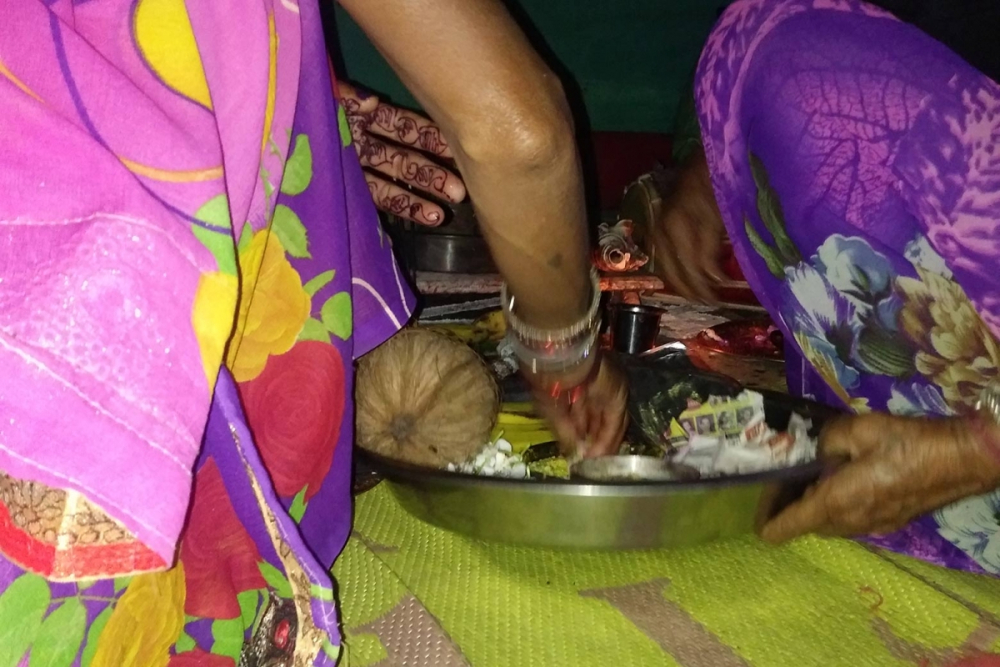
Figure 1: Preparation of Teeja Thaali
In the evening, she started off with preparing a thali for the puja.
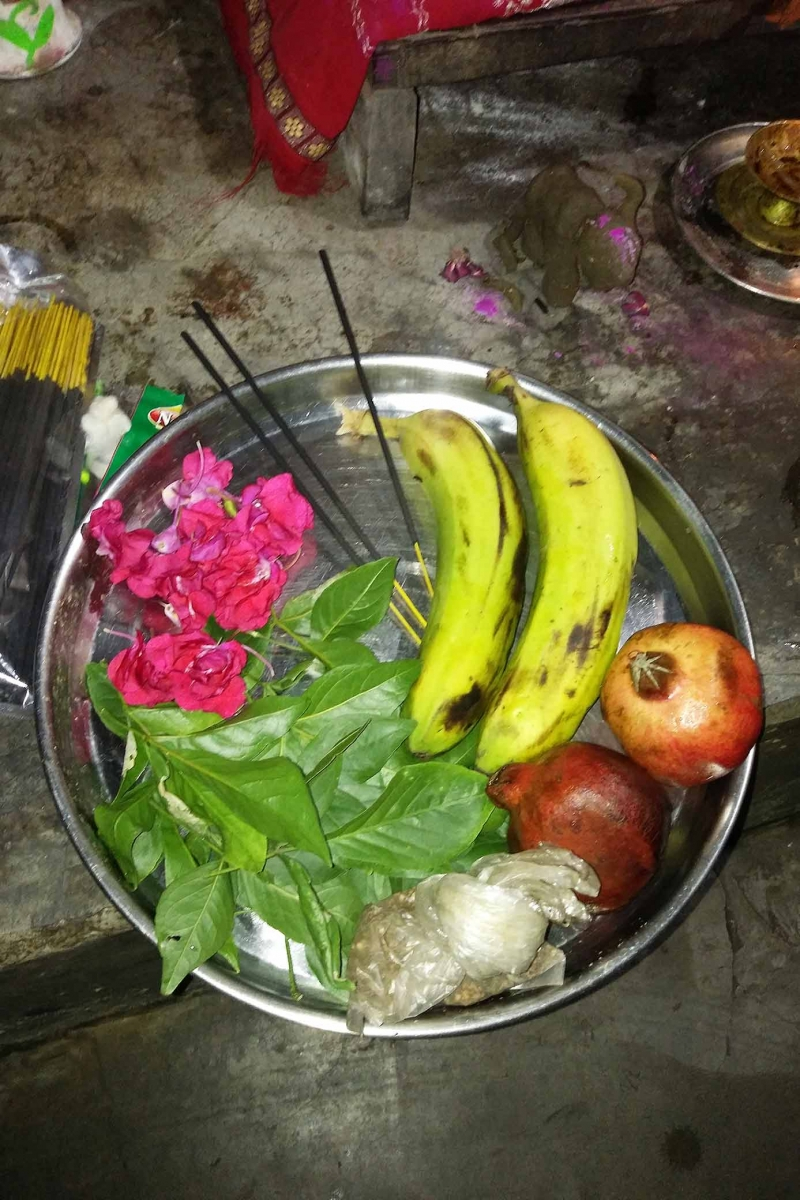
Figure 2: Prepared Teeja Thaali with Flowers, Fruits, Bel Patra, Incense Sticks and Marijuana
This thali contained aggarbatti (incense sticks), some fruits, flowers and bel patta.
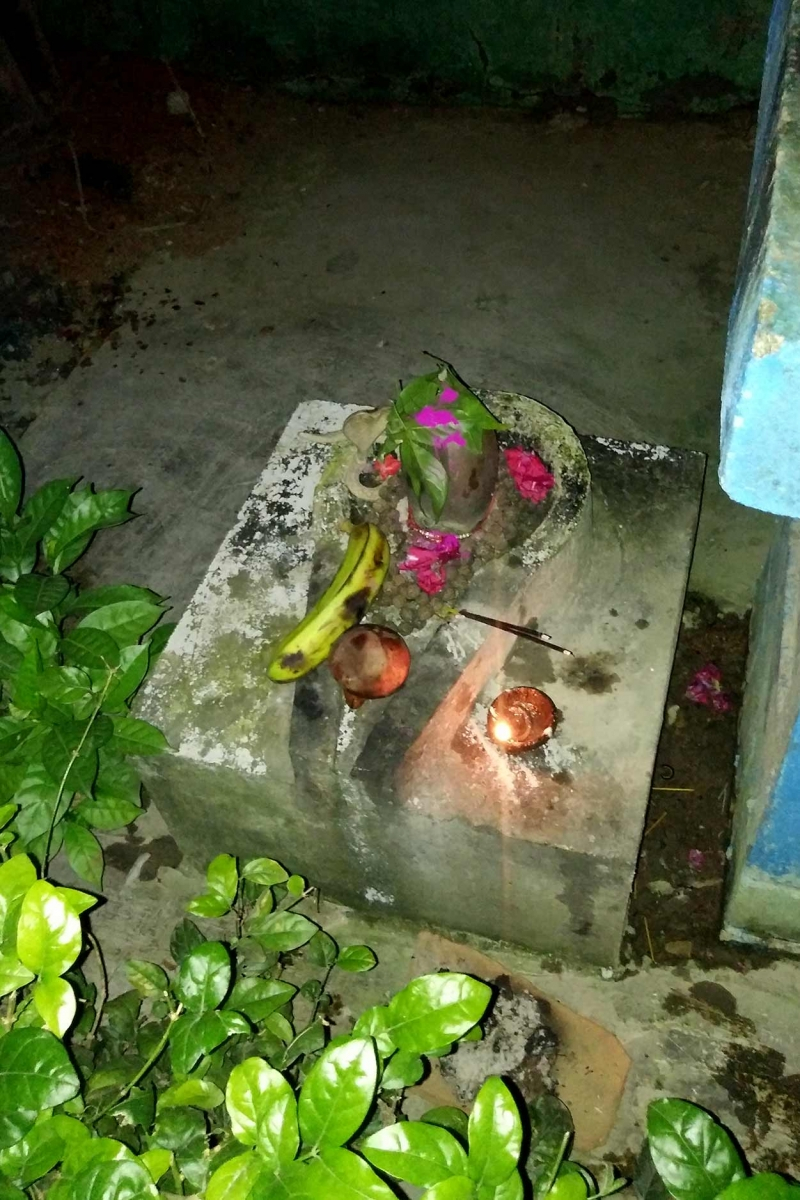
Figure 3: Teeja Thaali Offered to the Shivalinga
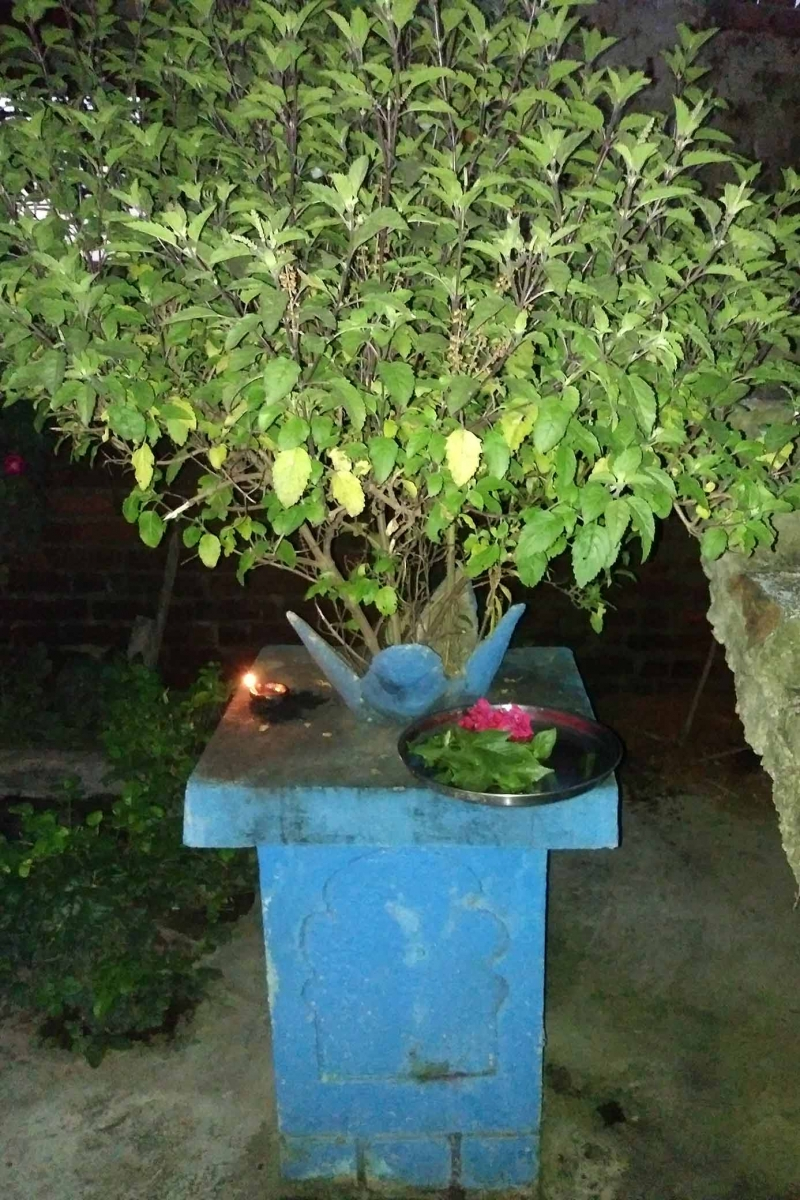
Figure 4: Tulsi Being Worshipped Alongside shivalinga on Teeja
Once the thali was prepared, she worshipped the Shivlinga kept alongside the Tulsi plant in the open courtyard of the house. Later, prayers were also made to other deities in the house, including ancestral deities. It is interesting to note, while the puja thali for Shivalinga contains marijuana, it is removed when prayers are made to other deities, particularly feminine.
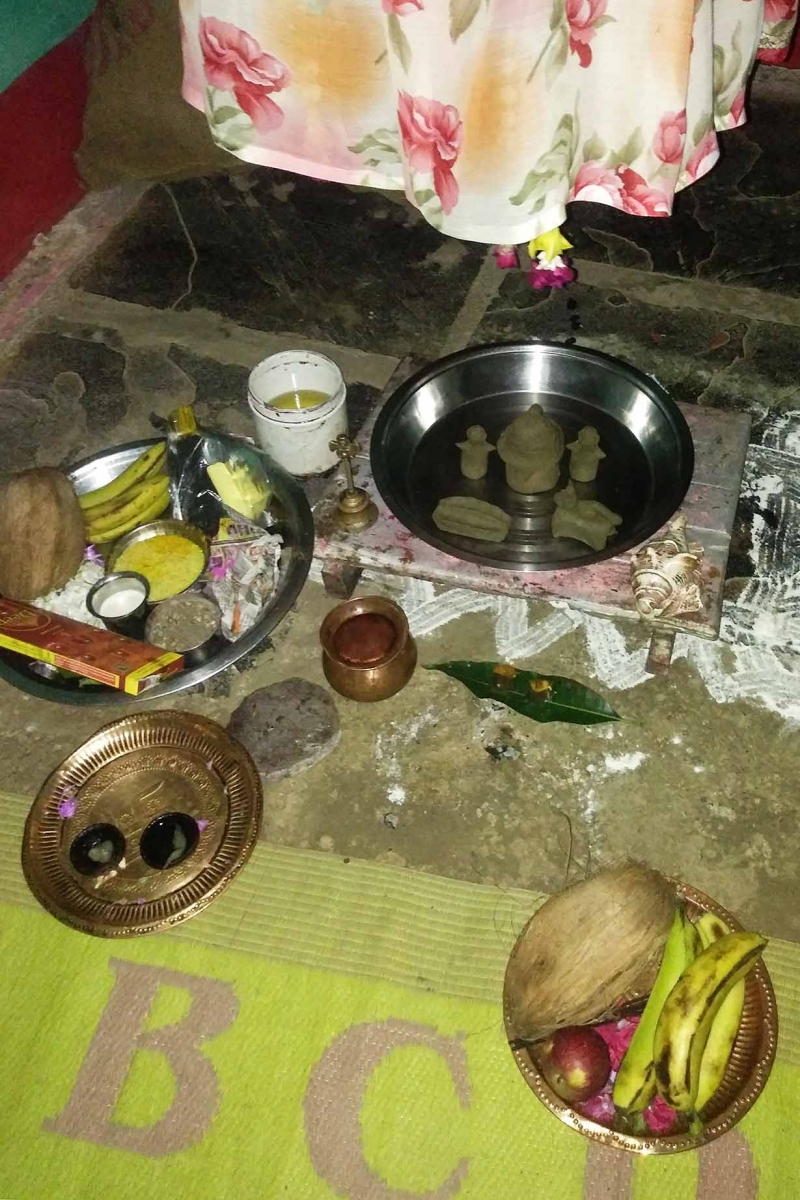
Figure 5: Preparation for Collective Puja on Teeja
After separate prayers, women gather for collective prayer. In the collective prayer, an assortment of offerings are made to Shiva and Parvati. Generally, women who gather in groups for collective prayers, set up a place with all the essentials for the puja. For instance, Balita Netam and her friends gathered in a small room (originally the store room of the house). Hanging above the place of puja, like a swing was a wrapped cloth. It was fashioned in such a manner, that it created an illusion of a swing with somebody sitting on it. For them it signified the god and, they rocked it while puja. However, the idea behind the ritual was unclear. Traditionally, the practice of ritually rocking a swing is associated with the cult of Krishna. Alternately, women in the states of Punjab, Haryana and Rajasthan put up swings and take turns to swing on it, meanwhile singing songs during Kajari Teej. Perhaps, the Chhattisgarh ritual is a rendition of this one.
The assortment of things gathered for Teeja puja by Balita and her friends included small forms of deities made in mud and clay. These included small figures of Ganesha, Shiva, Parvati and Nandi (the bull). The thali also had one other small structure, which looked like a plank. A few women offering puja explained that it was a boat. However, no one present in the ritual was sure what these figures signified and why they were kept in the thali, alongside other figures. Other things included, dry coconut, shankh, rice mixed with turmeric, flowers, fruits, kalash and diyas.
When women begin their collective prayer, the katha of Hartalika Teeja is narrated. The katha elaborates how goddess Parvati’s friends took her to the forest, so that she could offer worship to lord Shiva. The name of the festival, Hartalika derives from this incidence, which literally means ‘kidnapped by ones’ female friends.
The festival of Kajari Teej (also known as Badi Teej) marks the advent of the monsoon season. The name Kajari also indicates sky full of clouds. This festival signifies the 'union' of Parvati and Shiva, as does the season of monsoon. As Goddess Parvati gets her desires fulfilled with her union with Shiva, similarly, the earth gets her desire addressed in the form of rain. It is believed, that unmarried women who observe the fast of Teeja get husbands of their choice, while the life of married women are blessed and their desires are fulfilled.
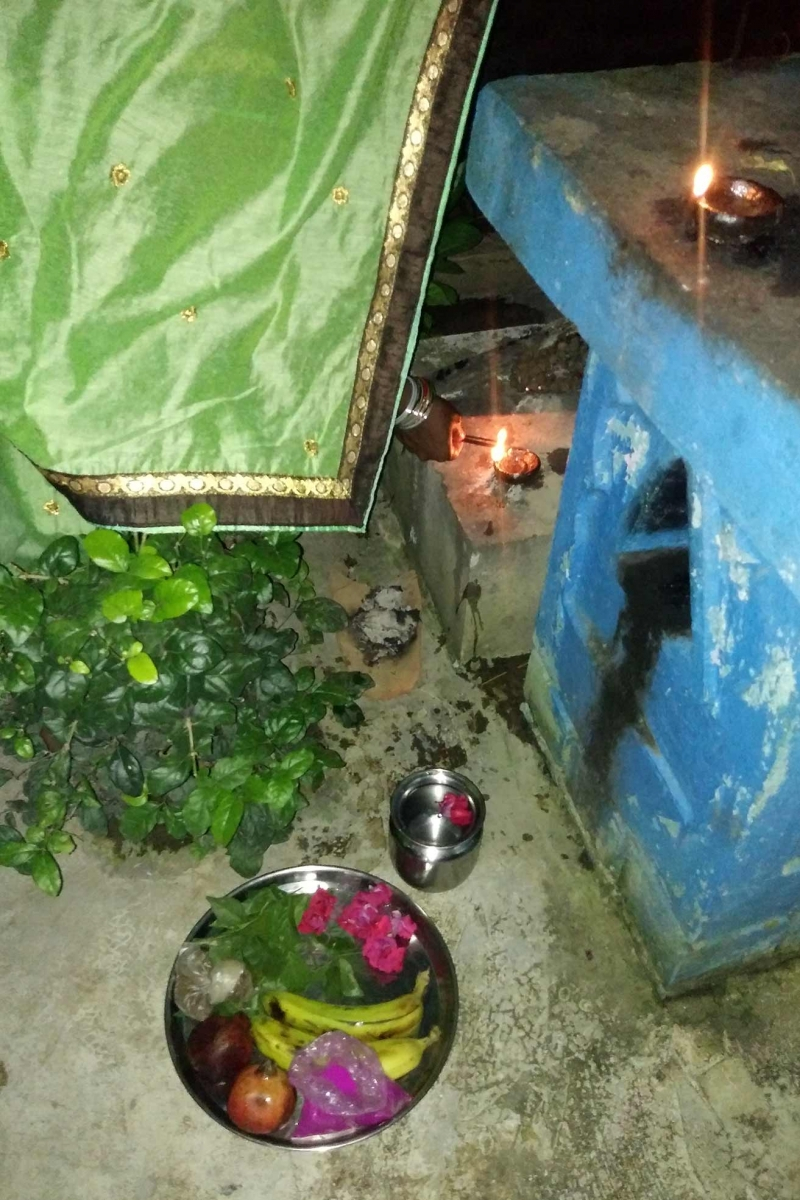
Figure 6: Lighting Diya in front of Tulsi
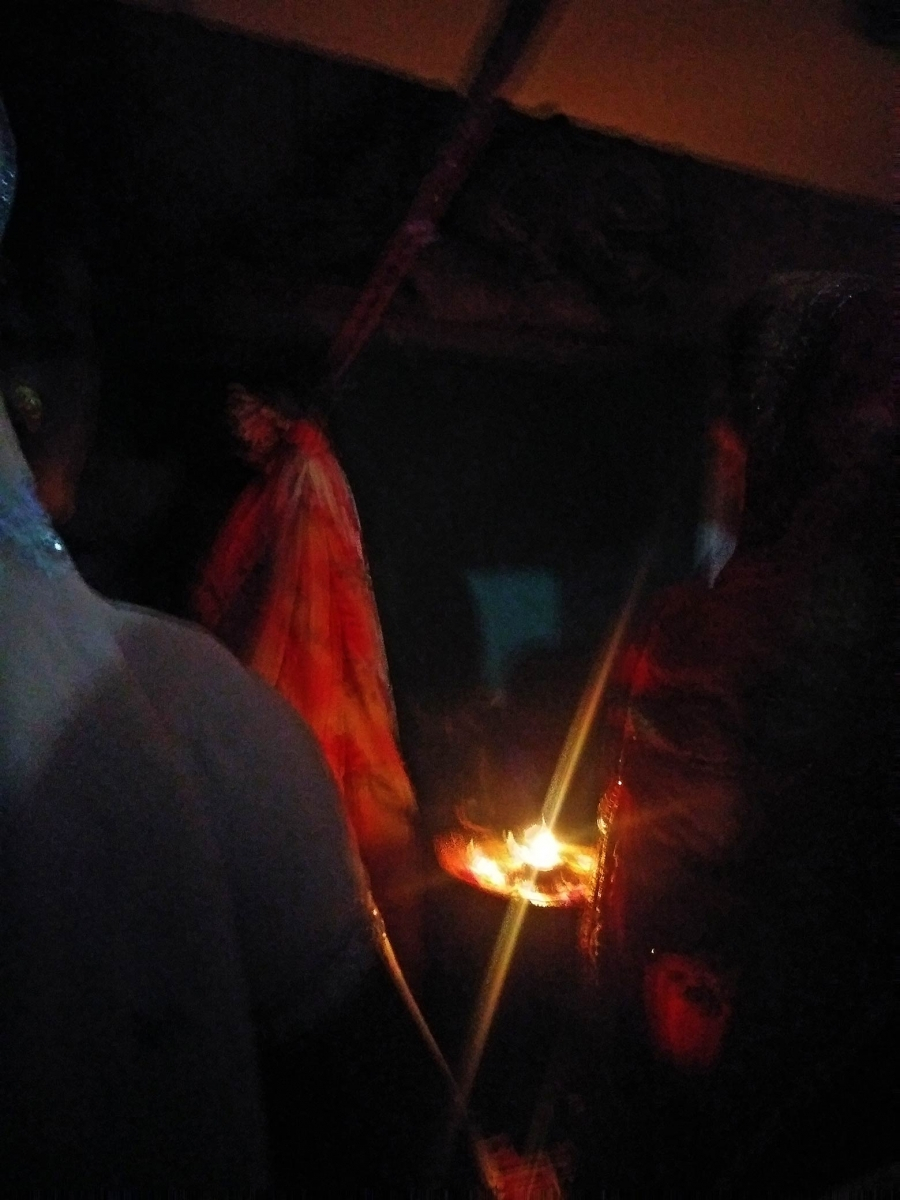
Figure 7: Teeja Aarti
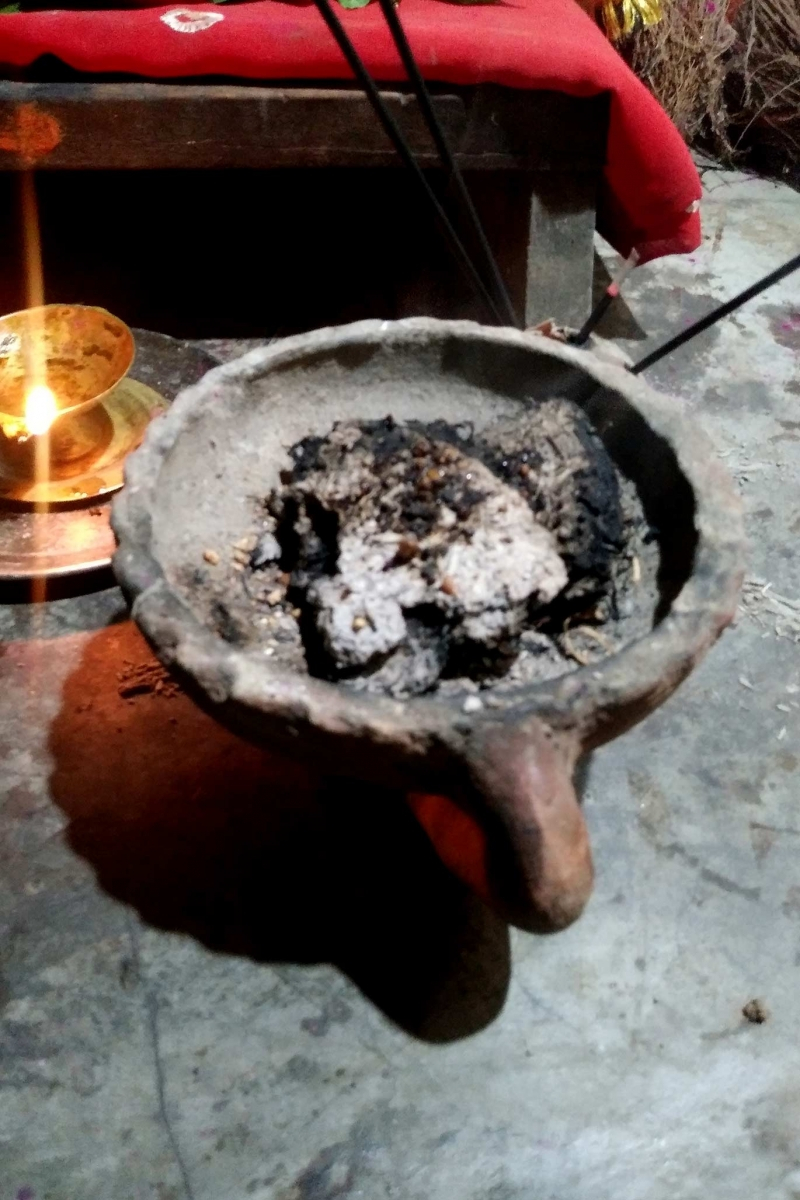
Figure 8: Teeja Aarti with Incense Sticks and Dupauli (dhoop)
After the katha, aarti is performed and, women continue singing prayers until midnight. This they say helps them to keep their mind off hunger. As they pass midnight, they have chai together and go to their respective houses to sleep. The next day different kinds of rotis (like bada, bhajia) are made for women to take home for their husbands.
Ganesha Chaturthi
Ganesh Chaturthi is celebrated on the next day of Teeja, On the first day, the idol of Ganesha is brought with pomp and installed at a place after which prayers are offered. The sthapna (installation) of the idol marks the birth of the god. The prayer rituals continue in the coming days. The number of days the idol is kept varies across regions. For instance, in Palwadi, one among the many villages (where I was present during the festival in Dhamtari), Ganesha was installed on the 13th September and visarjan was done on the 24th September. Until the day of visarjan, all the families in the village observed evening prayers at the Ganesha pandal. On the day of the visarjan, prayers were made and, with the same pomp the idol was immersed in the village pond.
Ganesh Chaturthi has become one of the chief events of the village. One encounters multiple pandals within a village. In Palwadi, for instance, there were three Ganesh pandals, which were decorated with cloth, flowers and vibrant lights. Every evening, the Ganesha aarti was performed at the pandal and people from nearby houses came to perform the aarti. Every evening, Komal Singh visited the pandal with some flowers for aarti, like many others and, sat at the pandal until late night to accompany the ones’ sleeping in the pandal.
The Ganesh pandals also become the focal-point of daily meetings during the event- in a way it becomes the centre of activity for children as well as the youth. Komal explains, that the pandal is never supposed to be empty, therefore, even at night people stay in it. In Palwadi, even a makeshift fountain was created with mud.
For the organisation of Ganesh Chaturthi a group is formed. It comprises of the youth of the village and some other men. Before the sthapna of the murti, these groups make all the plans and arrangements for the event. They start meeting a fortnight before the festival. It is their responsibility to setup the pandals and also procure items for it. Once the sthapna is done, they manage the daily work of getting fruits and flowers for puja and, looking after the maintenance of the pandal.
As we know these festivals are predominantly North Indian and Marathi in origin, it is intriguing to see their widespread celebration in Chhattisgarh. Upon enquiring about the beginning of these festivals in the region, we seek no answers. The people who organise and participate in these festivals claim to have forgotten about their genesis or meaning. For the festival of Teeja, the women who are in their late 40s share that they have been observing this fast since they got married. Some of them remembered their mothers doing the same fast, while some did not. Balita Netams’s mother, perhaps in her mid-50’s says, that she never kept the fast and neither did her mother. In conversation with these women, we cannot discern the introduction and adoption of these festivals. Similar is the case with Ganesh Chaturthi, which has become one of the most popular festival among the Gonds. These festivals have become prominent not only because of their religious and mythological aspects, but also because their celebration brings joy among the members of the community and, also provides an opportunity to work and participate collectively.
The changing cultural processes
As shared above, though the origin of these celebrations by the Adivasis is unclear, but they have somehow become a part of the Adivasi culture and religiosity. Koreti in her piece ‘Religion of the ‘Gond’ Tribes of Middle India’, discusses that the Gonds were not considered Hindus as they were different from them. She associates the Gond religiosity with their relationship to the nature. Nature for them presented various forms of Gods. This also holds true for the Gonds in present times. Gonds have different nature Gods, who they worship and believe to have made life sustainable. For instance, In the hilly terrains (called ghat or ghati), they are found in rock form and, recognised as Ghateshwar baba, who protects the ghats. The Mahamaya temple, located near village Farsiyan in the Nagri block of Dhamtari district presents an interesting picture of the change and confluence of cultures. The temple in the present time comprises of a large area, which has various separate room like structures, which houses the idols of different gods. The central part of the temple housed the figurine of Mahamaya, which was just a combination of two rocks and there was a pond adjacent to this structure. clearly, it was the older part of the temple. The other structures had idols of Ram, Lakshman, Sita, Hanuman, Ganesha and, were built in the last 50 years (each one of these structures have information placard in front stating their year of construction and the name of the patron). Over the years, there has been a drastic change in the cultural and religious practices of Gonds owing to the forces of globalisation and development (Bankar, nm). Today, the Gond Adivasis in Palwadi claim they are Hindus, meaning- that they follow Hindu festivals of Teeja and Ganesh Chaturthi, but they do it their way. There is no clear line of distinction between the cultural and religious aspects of these festivals, but as they have been widely adopted by Gond Adivasis within their cultural realm, their importance in shaping the belief and faith system of the Gonds cannot be denied.
Desire to celebrate
The clue to the adoption of these festivals by the Gond Adivasis in Dhamtari can be found in the way these festivals are organised and celebrated. As discussed above, both these festivals are big and important events in the village. They bring in an environment of celebration. Both these festivals also correspond with the end of monsoon, when one phase of the agricultural work culminates and people await the second phase. The organisation of these big events provide an opportunity to do something different from the routine, that is, the routine of the last few months, which have been spent working tirelessly in the fields. For the youth of the village, Ganesh Chaturthi becomes a medium to gather and engage in activities associated with entertainment. Ganesh Chaturthi also comprises celebration in the form of music and dance. Music in the pandals starts from 7 am and goes until late evening, when the aarti is performed. These pandals do not just play songs devoted to Ganesha, but play a variety of songs sometimes not even related to any god. At the time of sthapna and visarajan, the procession that caries the idol, one can see young girls and boys dancing on dhol music compilations and Bollywood songs. This dance goes on for quite some time. It starts in the morning when the idol is prepared for visarjan and can go on till early evening before the sunset, when the visarjan is done.
The festival of Teeja also marks a big event for women and, provides them a chance to go out of the village and re-unite with their sisters and friends. On asking women about how they manage to observe strict fasting, they shared that they do not find it very difficult, as most of the time they are engaged in something or the other, like going to the market, preparing for the puja, getting dressed, singing prayers together and, in all this excitement they forget about the food. They keep the fast not just (or entirely) because of the religious significance of the Teeja fasting, but simply because they like to keep the fast and participate in the ritual activities that come along. Balita Netam says, that there is one woman from the Yadav family in their village who observes the fast of Karva Chauth, and she is also tempted to start observing the fast. On asking why she wanted to start it she said, “banne lagte” (meaning, “she likes it”).
Scholars are divided into two groups on their opinion about the Teeja fast. While some believe that women fast for the benefit of their husbands and children, the other lot questions the women’s position in the power relations of the society and family. Indira Mishra in her paper 'Discourse of women empowerment in the making of Teej', delineates the two views on Teeja. On one side, she argues, that Teeja festival perpetuates women’s subversion and exploitation, while on the other side, she postulates that it is a festival where women get to fulfil their desires (for them, the story of Teeja inherently signifies the struggle of goddess Parvati against the society to get a suitable husband). Putting this together in the context of Bajarkurdih women, it becomes more of a festival of togetherness. From the above account of these festivals, perhaps it can be inferred that Teeja and Ganesh Chaturthi does not only hold a religious significance, but more importantly provide a platform, a medium of participating in the community celebrations. Though it is important to delve into the religious underpinnings of these festivals, at the same time, acknowledging that the present lifestyle and the belief system of the Adivasis and other communities are an admixture of decades of interaction and exchange within different religions and cultures is equally imperative. It is in this context, that these festivals and their celebratiosn by various communities across Bastar can be understood.
References:
Bankar, Anil R. 2016. "Adivasis culture in Maharashtra and its changing scenario."
International Multidisciplinary Research Journal 3(4): 121-127.
Bhagvat, Durga. 1968. "Tribal gods and festivals in central India." Asian Folklore Studies:
27-106.
Furer-Haimendorf, Christoph von, and Elizabeth von Furer-Haimendorf. 1980. "The Gonds
of Andhra Pradesh.". Winchester: George Allen and Unwin.
Koreti, Shamrao I.2015. "Religion of the ‘Gond’ Tribes of Middle India." South Asia
Culture, History and Heritage, International Association for Asian Heritage (IAAH) and
Centre for Asian Studies, University of Kelanya Sri Lanka. 86-93
Mishra, Indira. "Discourse of women empowerment in the making of Teej." JODEM: 81.
Websites:
http://www.bignetindia.com/lifestyle/teej-festival-date-history-traditional-stories-and-legends/
